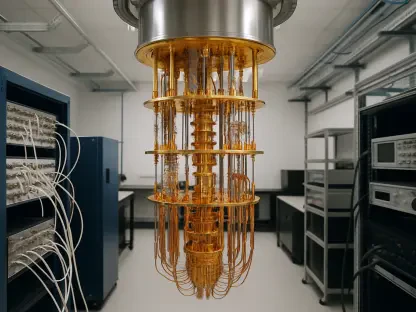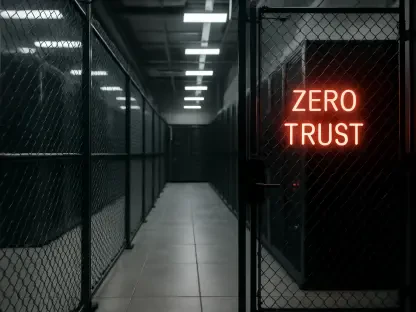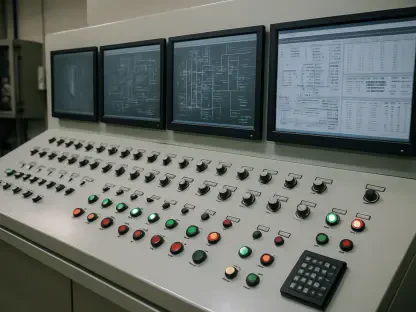Since Bitcoin’s inception in 2009, it has gradually embedded itself into mainstream consciousness, influencing various aspects of finance and technological infrastructure. One of the profound impacts has been on data center requirements. Initially, the internet’s dependency on broadband limited the vast deployment of data centers. However, as broadband infrastructure became ubiquitous by the late 2000s, the shift towards cloud computing and remote server clusters gained traction, cutting capital expenditures significantly and giving rise to giants like Amazon Web Services (AWS), Microsoft Azure, and Google Cloud.
Blockchain networks, designed to facilitate real-time transaction processing, necessitate robust CPU, GPU power, and memory to minimize latency and congestion. As blockchain technology and cryptocurrency mining operations have expanded, so has the pressure on data centers to transition from traditional client-to-server (north-to-south) architectures to more efficient spine-and-leaf (east-to-west) designs, which support peer-to-peer communication without passing through a congestible central point.
Emergence and Importance of Data Centers in the Crypto Industry
The Role of Data Centers in Crypto Integration
Data centers have become integral to the crypto industry, providing the backbone infrastructure for blockchain networks. Initially, data centers supported internet services and cloud computing. These facilities have evolved to handle the unique demands of blockchain technology, like real-time transaction processing and heavy computational requirements.
As the cryptocurrency ecosystem continually evolves, data centers have adapted to provide the necessary computational power to support blockchain networks. This increased demand for data processing and transaction validation has driven technological advancements in data centers, making them indispensable to the functionality of blockchain systems. The transition has not only been about handling data efficiently but also ensuring that the systems remain secure and resilient to the kinds of attacks that decentralized financial systems might face.
Evolution from Broadband to Cloud Computing
The shift from limited broadband infrastructure to widespread cloud computing has drastically changed data center economics. Cloud services offered by major tech companies have reduced capital expenditures, enabling more data centers to emerge and support the growing cryptocurrency ecosystem.
In the early days of the Internet, the expansion of broadband services was essential but limited by the existing infrastructure. By the late 2000s, the broad adoption of cloud computing technology drastically altered how data centers function. Innovations in cloud computing allowed data centers to operate on a scale unimaginable just a decade prior. This scalability has been essential for supporting the massive computational requirements of blockchain networks. The digitization of financial transactions and contracts facilitated by blockchain has necessitated a more robust and flexible data center infrastructure.
Enhanced Performance Requirements and Solutions
Transition from North-to-South to Spine-and-Leaf Architectures
Blockchain transactions require minimal latency, prompting a shift from traditional data center architectures to more efficient designs. Spine-and-leaf architectures enhance performance by eliminating bottlenecks and mimicking the decentralized nature of blockchain networks.
This transition focuses on enhancing performance for real-time processing, crucial for blockchain operations. In traditional north-to-south architectures, data flows between clients and servers vertically, often causing congestion at central points. Spine-and-leaf architectures, in contrast, allow for more horizontal (east-to-west) traffic flow, facilitating peer-to-peer communication. By distributing the load more evenly, these architectures ensure that no single point becomes a bottleneck, aligning well with the decentralized ethos of blockchain technology.
Non-Hierarchical Data Center Models for Reliability
Non-hierarchical architectures like spine-and-leaf improve reliability and security by avoiding single points of failure. These models align well with the peer-to-peer ethos of blockchain, ensuring robust and efficient transaction processing.
The structure of spine-and-leaf models inherently supports redundancy, making it more resilient to various types of disruptions. Traditional hierarchical models risk entire systems going offline due to central point failures. In contrast, the decentralized nature of spine-and-leaf models distributes the risk, making transaction processing not only faster but also more reliable. Such structures are paramount for blockchain networks that demand high uptime and immediate transaction validation without compromising data integrity.
Energy Consumption and Efficiency Challenges
Increasing Energy Demands of Blockchain Networks
Blockchain networks consumed about 460 trillion watt-hours (TWh) of electricity globally in 2022, with projections suggesting a doubling by 2026. This growing energy demand poses significant challenges and has led to innovative solutions to address sustainability concerns.
The high energy consumption of blockchain operations is largely driven by the intensive computational processes required for mining and transaction validation. As blockchain technology scales, so too does its energy footprint. Addressing this challenge has become a focal point for both the crypto industry and data centers, which are exploring various methods to improve energy efficiency. Sustainable practices, such as investing in renewable energy sources and optimizing cooling systems, are becoming more prevalent as ways to mitigate the environmental impact.
Sustainable Energy Solutions and New Practices
Efforts to meet escalating energy demands sustainably include Microsoft’s 20-year deal with Constellation Energy to restart nuclear reactors. In Europe, the endorsement of Small Modular Reactors (SMRs) demonstrates attempts to balance increased demand with decarbonization efforts.
These partnerships highlight a broader trend towards sustainable energy solutions in the data center and crypto mining sectors. Small Modular Reactors, for example, offer a potentially scalable and low-carbon solution to the energy needs of large-scale data centers. By strategically aligning with energy providers committed to green initiatives, the crypto industry not only ensures a stable power supply but also works towards reducing its overall carbon footprint. This alignment is crucial as the world pivots towards more eco-friendly practices.
Proximity to Power Plants to Reduce Transmission Losses
Direct Power Connections for Efficiency
To maximize electricity efficiency, data centers for crypto are moving closer to power plants to minimize energy loss during transmission. Examples include New York state’s power plant connecting directly to servers, enhancing economic viability.
By situating data centers closer to their power sources, significant efficiency gains can be achieved. This proximity minimizes the energy lost during transmission, which is crucial for operations requiring enormous and consistent power like cryptocurrency mining. The direct connection to power plants not only enhances operational feasibility but also reduces costs associated with energy loss. Such infrastructural changes reflect a growing trend of integrating data centers more closely with their surrounding energy ecosystems to optimize performance and sustainability.
Flexible Load Demands for Grid Stabilization
Proximity to power sources allows crypto mining operations to act as flexible load demands, stabilizing electrical grids. This strategy not only boosts efficiency but also supports broader energy grid stability.
Integrating crypto mining operations as flexible loads helps in balancing supply and demand within power grids. During periods of low energy demand, mining activities can ramp up, consuming excess electricity that might otherwise go to waste. Conversely, during peak demand times, mining activities can be scaled down to relieve pressure on the grid. This balancing act helps in stabilizing the overall grid system, reducing the likelihood of blackouts, and making more efficient use of generated power. This approach also showcases the potential of crypto mining operations to contribute positively to broader energy management strategies.
Adapting Data Center Design for Blockchain Technology
Specialized Mechanical, Electrical, and Plumbing (MEP) Requirements
The high thermal loads from continuous cryptographic computations necessitate advanced cooling mechanisms. Traditional air cooling is being supplemented by direct-to-chip liquid cooling or immersion cooling to handle increased power densities effectively.
These advanced cooling techniques are designed to address the specific needs of high-performance data centers dedicated to blockchain operations. Direct-to-chip liquid cooling systems provide targeted cooling to the hottest parts of the hardware, thereby increasing efficiency and uptime. Similarly, immersion cooling surrounds the entire electronic assembly in a thermally conductive but electrically non-conductive liquid, which significantly improves heat dissipation. These specialized methodologies are essential to sustain the operational integrity and performance of data centers handling large-scale blockchain computations.
Redundancy Tiers and Managing Costs
Different redundancy tiers, as defined by the Uptime Institute, help data centers mitigate risks of downtime. Although Tier IV redundancy is costly, it is essential for networks requiring near-instant transactions, justifying the investment for critical blockchain projects.
Redundancy tiers range from basic (Tier I) to fault-tolerant (Tier IV), with each level providing different degrees of redundancy and resilience. Critical blockchain applications often necessitate the highest level of redundancy to guarantee seamless operation even in the event of multiple system failures. While achieving Tier IV status involves substantial investment in infrastructure, power backups, and cooling systems, it ensures the highest uptime and reliability. This level of assurance is indispensable for industries that depend on instant, uninterrupted transaction processing, such as financial services powered by blockchain technology.
Economic Viability and Sustainability of Crypto Mining Operations
Impact of Bitcoin Halving Events
Bitcoin’s halving events reduce mining rewards, raising concerns about economic sustainability. However, improved mining efficiency and historical trends suggest that post-halving price increases will sustain profitability, bolstered by innovative energy utilization methods.
The cyclical nature of Bitcoin halving events introduces periodic adjustments within the mining community. While the reduction in rewards might initially seem detrimental, historical data often shows a subsequent increase in Bitcoin price, which can offset the impact on mining revenue. Additionally, miners are continually seeking more efficient ways to conduct operations, from using next-generation ASICs (Application-Specific Integrated Circuits) to adopting renewable energy sources. These proactive measures contribute to maintaining the economic viability of mining operations, even as the digital currency evolves.
Integrating Sustainable Practices in Crypto Mining
Legislative incentives and innovative practices, such as redirecting flared gas to mobile data centers or using excess heat for industrial processes, enhance the economic and environmental sustainability of crypto mining operations.
Recent legislative moves, such as Texas’ House Bill 591, encourage activities that harmonize mining operations with environmental goals. By redirecting excess natural gas that would otherwise be flared into mobile data centers, cryptocurrency miners can positively impact the environment while maintaining operational costs. Similarly, the utilization of excess heat generated by data centers for local heating needs, such as greenhouses, exemplifies a circular economy approach. These sustainable practices not only make mining profitable but also contribute to broader ecological and community benefits.
Integration and Future Prospects
Hybrid Approaches for Data Centers
The convergence of crypto mining and AI infrastructure presents a lucrative opportunity for data centers. By balancing GPU servers for AI and ASIC machines for Bitcoin mining, data centers can optimize performance and sustainability.
Hybrid data centers offer a versatile solution by accommodating both AI computations and blockchain mining tasks. This combination allows data center operators to maximize their infrastructure’s utility without needing separate facilities for each type of operation. By dynamically allocating resources between AI tasks and mining activities, data centers can achieve higher efficiency and throughput. This approach not only leads to better economic returns but also sets a precedent for future data centers to integrate multiple high-performance computing tasks efficiently.
Shifting Perspectives on Crypto Mining
Non-hierarchical architectures, such as spine-and-leaf, enhance both reliability and security by eliminating single points of failure. These models are well-suited to the peer-to-peer philosophy of blockchain, facilitating robust and efficient transaction processing.
Spine-and-leaf models inherently promote redundancy, offering greater resilience against various disruptions. Traditional hierarchical setups are vulnerable to central point failures that can bring entire systems offline. In contrast, the decentralized approach of spine-and-leaf models distributes risk, making transaction processing faster and more dependable. For blockchain networks, which require high uptime and rapid transaction validation, such structures are critical. These networks demand immediate validation of transactions without sacrificing data integrity.
The backbone of spine-and-leaf architecture is its ability to ensure that multiple pathways exist between data points, which significantly reduces the chances of a bottleneck or failure causing system-wide issues. This attribute is crucial for blockchain networks where continuous operation and data accuracy are non-negotiable. The architecture allows for seamless scaling, accommodating growing amounts of data and transactions without degrading performance.
Thus, spine-and-leaf models offer a robust, efficient, and reliable framework that aligns perfectly with the decentralized, peer-to-peer nature of blockchain, ensuring that transactions are processed quickly and securely, upholding the integrity of the entire network.









